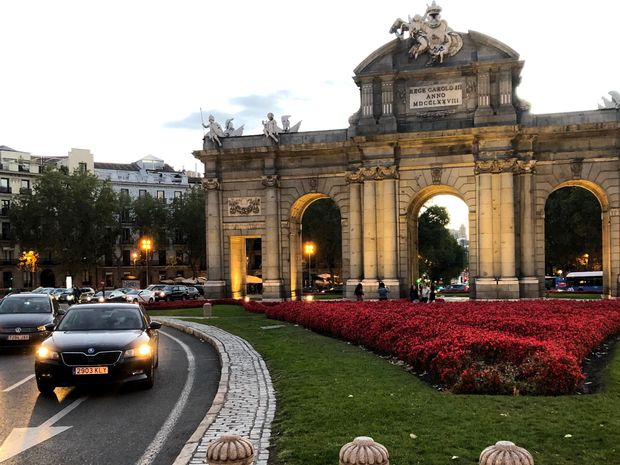
Madrid’s Puerta de Alcala on Oct. 3, 2020.
MarketWatch/Kollmeyer
Just hours ahead of the start of a long holiday weekend, the Spanish government put the Madrid region under a state of emergency on Friday, determined to stop an exodus of potentially infected residents.
In past years, Monday’s Hispanic Day holiday would have seen Spaniards clog highways and trains to reach their beach and countryside second homes. But surging coronavirus cases in the Madrid region, one of the worst infected in Spain, had the government scrambling to curtail those plans.
Prime Minister Pedro Sánchez’s leftist coalition government and Madrid’s right-wing premier Isabel Díaz Ayuso have been at loggerheads for weeks over how to combat the region’s climbing cases.
A week ago, fresh restrictions were ordered by the central government for all areas of Spain that met certain criteria, which included Madrid. The rules limit residents to their region or municipality, except under certain situations, impose capacity restrictions and closure times for businesses of 10 p.m. and 11 p.m. for bars and restaurants. As well, no more than six people can gather either inside or outside at one time.
Ayuso fought the measures with legal action and appeared to briefly win the battle when a high court on Thursday ruled that the government needed a state of alarm, such as was seen in the spring, to limit free movement. According to El País, which cited a government source, Ayuso refused to negotiate and the state of alarm went ahead for nine municipalities in the region, including the capital.
“At this point, patience has a limit. None so blind as those who will not see,” said Salvador Illa, Spain’s health minister, at a news conference on Friday. “As a consequence, we have to take measures to protect the health of Madrilenos and avoid the situation spreading to other regions and put in danger the health of more people.”
Illa added that it was “extremely important” that Madrid’s high infection rates not spread across the rest of Spain. The state of emergency will last for 15 days and Sánchez can’t extend it without further support from the Congress of Deputies and the lower house of parliament, said El País.
On Thursday, the government reported Spain had seen 256 positive cases per 100,000 people over the last 14 days, which was a slight improvement on the 269 reported a week ago. The Madrid region dropped from 647 to 563, and the harder-hit Navarra region fell to 655 from 692, respectively, data showed. Spain’s official death toll stands at 32,688.
The World Health Organization said that there was a record one-day increase in global cases over the last 24 hours. Spain has thus far managed to avoid the national catastrophe of the spring, and so hospitals are not overrun and the death rate is far lower than earlier this year.
The big difference this time for those under the state of emergency is that they won’t be confined to their homes such as in the spring, unless they are quarantining due to COVID-19. Still, many in the capital city are staying home or frequenting the city’s cafes and restaurants far less often, as jobless levels soar in the capital city long emptied of its mass of foreign visitors.
#Despeñaperros was trending on Twitter, in reference to a canyon in Andalusia. Twitter users were joking that Andalusians would fight to defend against invading Madrid tourists this weekend:
The government is obviously not leaving anything to chance. Spain’s National Guard tweeted that roadblocks would be set up in the Madrid region to ensure travelers adhere to the confinement rules:










Add Comment